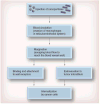Shaping cancer nanomedicine: the effect of particle shape on the in vivo journey of nanoparticles
- PMID: 24354814
- PMCID: PMC4057606
- DOI: 10.2217/nnm.13.191
Shaping cancer nanomedicine: the effect of particle shape on the in vivo journey of nanoparticles
Abstract
Recent advances in nanoparticle technology have enabled the fabrication of nanoparticle classes with unique sizes, shapes and materials, which in turn has facilitated major advancements in the field of nanomedicine. More specifically, in the last decade, nanoscientists have recognized that nanomedicine exhibits a highly engineerable nature that makes it a mainstream scientific discipline that is governed by its own distinctive principles in terms of interactions with cells and intravascular, transvascular and interstitial transport. This review focuses on the recent developments and understanding of the relationship between the shape of a nanoparticle and its navigation through different biological processes. It also seeks to illustrate that the shape of a nanoparticle can govern its in vivo journey and destination, dictating its biodistribution, intravascular and transvascular transport, and, ultimately, targeting of difficult to reach cancer sites.
Figures




References
-
- Lasic DD, Papahadjopoulos D. Liposomes revisited. Science. 1995;267(5202):1275–1276. - PubMed
-
- Maeda H, Wu J, Sawa T, Matsumura Y, Hori K. Tumor vascular permeability and the EPR effect in macromolecular therapeutics: a review. J Control Release. 2000;65(1–2):271–284. - PubMed
-
- Gradishar WJ, Tjulandin S, Davidson N, et al. Phase III trial of nanoparticle albumin-bound paclitaxel compared with polyethylated castor oil-based paclitaxel in women with breast cancer. J Clin Oncol. 2005;23(31):7794–7803. - PubMed
-
- Lasic DD. Doxorubicin in sterically stabilized liposomes. Nature. 1996;380(6574):561–562. - PubMed
-
- Safra T. Cardiac safety of liposomal anthracyclines. Oncologist. 2003;8 (Suppl 2):17–24. - PubMed
Publication types
MeSH terms
Grants and funding
LinkOut - more resources
Full Text Sources
Other Literature Sources
